Thomas Lehn and Marcus Schmickler
Lampo Performance Series
Feb 17, 2018
(8pm)
RSVP Required
Thomas Lehn and Marcus Schmickler have worked together since 1998. In their long musical collaboration, they confront intrinsically different instruments—for Thomas, the modular synthesizer, and for Marcus, the computer—with a common understanding of real-time composition and a shared admiration for subtle degrees of musical intensity.
Here, the analog-digital duo premieres Prediction Control Allocation—a three-part improvisation and a new performance strategy, with each section exploring a different musical form. Lehn and Schmickler take their cue from Point Line Cloud by composer and researcher Curtis Roads, while referencing the formal ideas of Stockhausen, Xenakis and Ligeti. Sounds scatter, fuse and then mutate, as they flow into other sounds.
Thomas Lehn (b.1958, Fröndenberg, Germany) has been working as a performer, interpreter, composer, and improviser of contemporary music since the early 1980s. Rooted in the experience of a wide spectrum of musical fields and based on his background as a pianist, he has developed an individual "language" of electronic music. The electronic equipment he uses consists of analog synthesizers from the late 1960s, particularly the EMS Synthi A. The specific character of this modular instrument allows him to act and react spontaneously in close contact with the various structural degrees of the musical process.
Marcus Schmickler (b.1968, Cologne, Germany) studied composition and electronic music and works in both composed and improvised forms. He has won numerous prizes and honors and is closely associated with the Cologne label a-Musik. As a composer along with his many works of electronic music, he works with the ensemble recherche, the Staatskapelle Weimar, the musikFabrik, the Paragon Ensemble, the Ensemble Zeitkratzer, among others. As a musician he works with artists such as John Tilbury, Thomas Lehn, MIMEO and Julee Cruise. His discography consists of over 50 titles, and he has performed internationally. He lives and works in Cologne.
Thomas Lehn and Marcus Schmickler performed at Lampo in September 2005, later released on Navigation Im Hypertext (a-Musik). Lehn's Lampo debut dates back to May 2003. Schmickler has performed several times in the Lampo series, first in September 2002 and most recently in March 2014.
Support for this program is provided by the Goethe-Institut of Chicago and the Graham Foundation for Advanced Studies in the Fine Arts. Since 2010 the Graham Foundation has supported and partnered with Lampo to produce this performance series held at the Madlener House. Lampo, founded in 1997, is a non-profit organization for experimental music and intermedia projects.

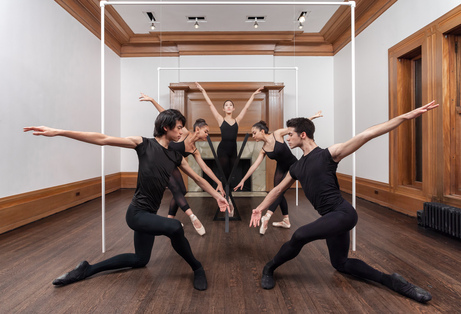
MASTERING FORM: Considering Architecture, Object and Body in the work of Brendan Fernandes
Hendrik Folkerts
Feb 15, 2018
(6pm)
Talk
Please RSVP
Please join us as curator Hendrik Folkerts reflects on architecture, object, and body in the work of Brendan Ferndandes in a new talk prepared in response to our current exhibition The Master and Form. The talk will be followed by a Q&A and conversation between Folkerts and Fernandes.
Hendrik Folkerts is the Dittmer Curator of Modern and Contemporary Art at the Art Institute of Chicago and one of the curators of documenta 14, which took place in Kassel and Athens in 2017. He studied Art History at the University of Amsterdam, specializing in contemporary art and theory, feminist practices, and performance. From 2010 until 2015 he was curator of Performance, Film & Discursive Programs at the Stedelijk Museum in Amsterdam. Prior to this, Folkerts was coordinator of the Curatorial Program at De Appel arts centre in Amsterdam from 2009 until 2011. He frequently publishes in journals and magazines such as South as a State of Mind, Mousse Magazine, Artforum, The Exhibitionist, Metropolis M, The Journal for Art and Public Space, Afterall Online, as well as monographs and exhibition catalogues. Folkerts is co-editor of Shadowfiles: Curatorial Education (Amsterdam: de Appel arts centre, 2013) with Ann Demeester; and Facing Forward: Art & Theory from a Future Perspective (Amsterdam: AUP, 2015) with Christoph Lindner and Margriet Schavemaker. He is one of the founding editors of the peer-reviewed journal Stedelijk Studies.
Image: View of "Brendan Fernandes: The Master and Form." 2018, Graham Foundation, Chicago. Design: Norman Kelley; dancers: Satoru Iwasaki, Yuha Kamoto, Andrea de León Rivera, Antonio Mannino, Leah Upchurch; photo: RCH
For more information on the exhibition, Brendan Fernandes: The Master and Form Installation in collaboration with Norman Kelley, click here.

View of "Brendan Fernandes: The Master and Form." 2018, Graham Foundation, Chicago. Design: Norman Kelley; dancers: Satoru Iwasaki, Yuha Kamoto, Andrea de León Rivera, Antonio Mannino, Leah Upchurch; photo: RCH
Performance followed by Brendan Fernandes in conversation with Zachary Whittenburg
Feb 10, 2018
(1pm)
Please RSVP
Please join us for a performance featuring dancers from the Joffrey Academy of Dance followed by a conversation between Brendan Fernandes and Zachary Whittenburg.
Brendan Fernandes is a Chicago-based Canadian artist of Kenyan and Indian descent. He completed the Independent Study Program of the Whitney Museum of American Art (2007) and earned his MFA from the University of Western Ontario (2005) and his BFA from York University in Canada (2002). Fernandes has exhibited widely domestically and abroad, including exhibitions at the Solomon R. Guggenheim Museum, New York; Museum of Modern Art, New York; Museum of Art and Design, New York; Musée d'art contemporain de Montréal; The National Gallery of Canada, Ontario; The Brooklyn Museum, New York; The Studio Museum in Harlem, New York; Mass MoCA, North Adams, MA: The Andy Warhol Museum, Pittsburgh, PA; Deutsche Guggenheim, Berlin; Bergen Kunsthall, Norway; Stedelijk Museum, Amsterdam; The Sculpture Center, New York; The Quebec City Biennial; and the Third Guangzhou Triennial in China. His recent monograph Still Move, was published by Black Dog Press, London, fall 2016. He is currently artist-in-residence and faculty at Northwestern University in the Department of Art Theory and Practice, and is represented by Monique Meloche Gallery, Chicago.
Colorado native Zachary Whittenburg spent ten years as a professional dancer with companies including Hubbard Street Dance Chicago, BJM Danse Montréal, Pacific Northwest Ballet, and Charlotte Ballet. Since then, he has collaborated with Lucky Plush Productions, Same Planet Performance Project, and Molly Shanahan / Mad Shak on performance and choreographic work; and has lectured and led workshops nationally and internationally. From 2009-12 he was the dance editor at Time Out Chicago and has written for numerous print and online publications including regular contributions to Dance Magazine. Formerly the associate director of marketing and communication at Hubbard Street Dance Company, he currently serves as the communications and engagement director at Arts Alliance Illinois. Whittenburg remains engaged with dance as a founding member of the executive committee for the Chicago Dance History Project, and serves on the artistic advisory council for High Concept Labs.
The Joffrey Academy of Dance, Official School of The Joffrey Ballet, is committed to providing students of all ages, levels and backgrounds who have a desire to dance with a world-class education built on a foundation of classical ballet. With the talents cultivated at the Joffrey Academy, students can pursue careers as professional dancers at companies throughout the world, higher education opportunities in dance, or success in other fields. Through the Joffrey Academy’s programs, students develop a diverse set of skills including artistry, creativity, discipline and confidence, among others. The Joffrey Academy’s high-quality, educational programming forms future audiences and support for the Joffrey and builds the organization’s reputation worldwide.
Image: View of "Brendan Fernandes: The Master and Form." 2018, Graham Foundation, Chicago. Design: Norman Kelley; dancers: Satoru Iwasaki, Yuha Kamoto, Andrea de León Rivera, Antonio Mannino, Leah Upchurch; photo: RCH
For more information on the exhibition, Brendan Fernandes: The Master and Form Installation in collaboration with Norman Kelley, click here.

Andreas Angelidakis, Polemos, 2016.
Disoriented Objects
Jaffer Kolb
Feb 01, 2018
(6pm)
Talk
Please RSVP
|
Please join us for a talk by Jaffer Kolb, guest editor of Graham funded Log 41, which includes a special section called "Working Queer" with contributions by Ellie Abrons, Andreas Angelidakis, Annie Barrett, Caitlin Blanchfield & Farzin Lotfi-Jam, Stratton Coffman, Mustafa Faruki, Nicholas Gamso, Andrew Holder, Andrés Jaque, Jaffer Kolb & Aaron Betsky, Ang Li, Michael Meredith, Ivan L. Munuera, Joel Sanders, Rosalyne Shieh, and Michael Wang.
In the discipline of architecture, "queerness" has been understood primarily in terms of how it relates to space—from bathrooms to locker rooms; spatial transgressions to phenomenal strategies of "seeing.” But what if we understood the term less as what we design and more how. That is, to think of queerness as a methodology: a way of working, an approach to research, a framework for dealing with history. In this formulation, space opens up to a range of new kinds of practices that work across scales (from building to artifact), across media (from material assembly to performance), and across forms. Together, tactics of queerness such as humor, subversion, caricature, exaggeration, and others, can be used to disorient objects themselves: to see them anew, to give them new context, to understand how they perform as socio-cultural representations. This talk will look at a few disoriented objects as a means of unpacking the potential of this queer project—to test the theory and determine whether we can affect our tools with a renewed sense of critical action.
Jaffer Kolb is a designer based in New York and co-founder of the architectural practice N/A. He sometimes writes, sometimes curates, and often teaches (currently at Pratt Institute, and most recently at Princeton University's School of Architecture). He was the 2015 Muschenheim Fellow at the University of Michigan, and before that worked as a designer in New York, Chicago, and Los Angeles. His work has appeared in numerous exhibitions and has been published internationally. Previously he worked on the 13th Venice Architecture Biennial under David Chipperfield, and before that served as the US Editor of the Architectural Review. As a design journalist and critic, he has written for numerous publications internationally. He holds a Master of Architecture from Princeton University, a Master’s in Urban Planning from the London School of Economics, and his Bachelor of Arts in Film Studies from Wesleyan University.
Kolb received a Graham Foundation Exhibition grant in 2016 for Cross-Sections: Four Views of Emerging Artists and Architects with Chelsea Culprit, Ben Foch, Ian Quate, and Colleen Tuite.
This talk is presented in relationship to our concurrent exhibition, Brendan Fernandes: The Master and Form, for more information click here.
Related Graham Foundation supported project:
2017 Publication grant to Anyone Corporation for Log: Observations on Architecture and the Contemporary City
|
Image: Andreas Angelidakis, Polemos, 2017, foam and vinyl seating modules, installation view, Fridericianum, Kassel, documenta 14, photo: Nils Klinger
For more information on the exhibition, Brendan Fernandes: The Master and Form Installation in collaboration with Norman Kelley, click here.

View of "Brendan Fernandes: The Master and Form," in development, 2017, Graham Foundation, Chicago. dancer: Leah Upchurch, photo and rendering: Norman Kelley
The Master and Form, Opening Performance and Reception
Brendan Fernandes
Jan 25, 2018
(6pm)
Opening Reception
Please RSVP
Please join us for a opening performance and reception with Brendan Fernandes, Norman Kelley, and dancers from the Joffrey Academy of Dance on January 25, 2018 from 6–8:00 p.m.
For more information on the exhibition, Brendan Fernandes: The Master and Form Installation in collaboration with Norman Kelley, click here.

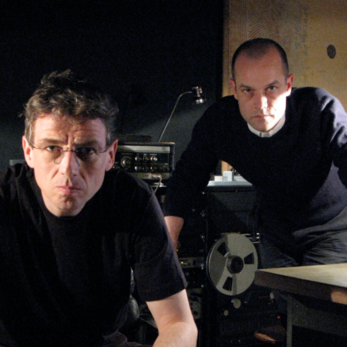

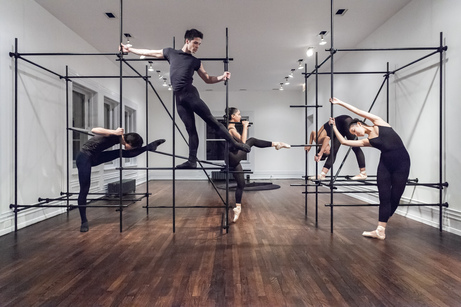
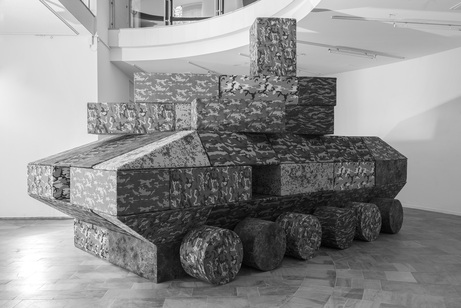
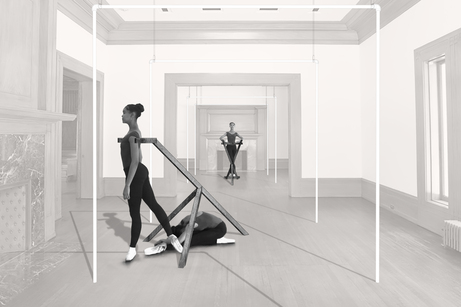
 PREVIOUS POSTS
PREVIOUS POSTS